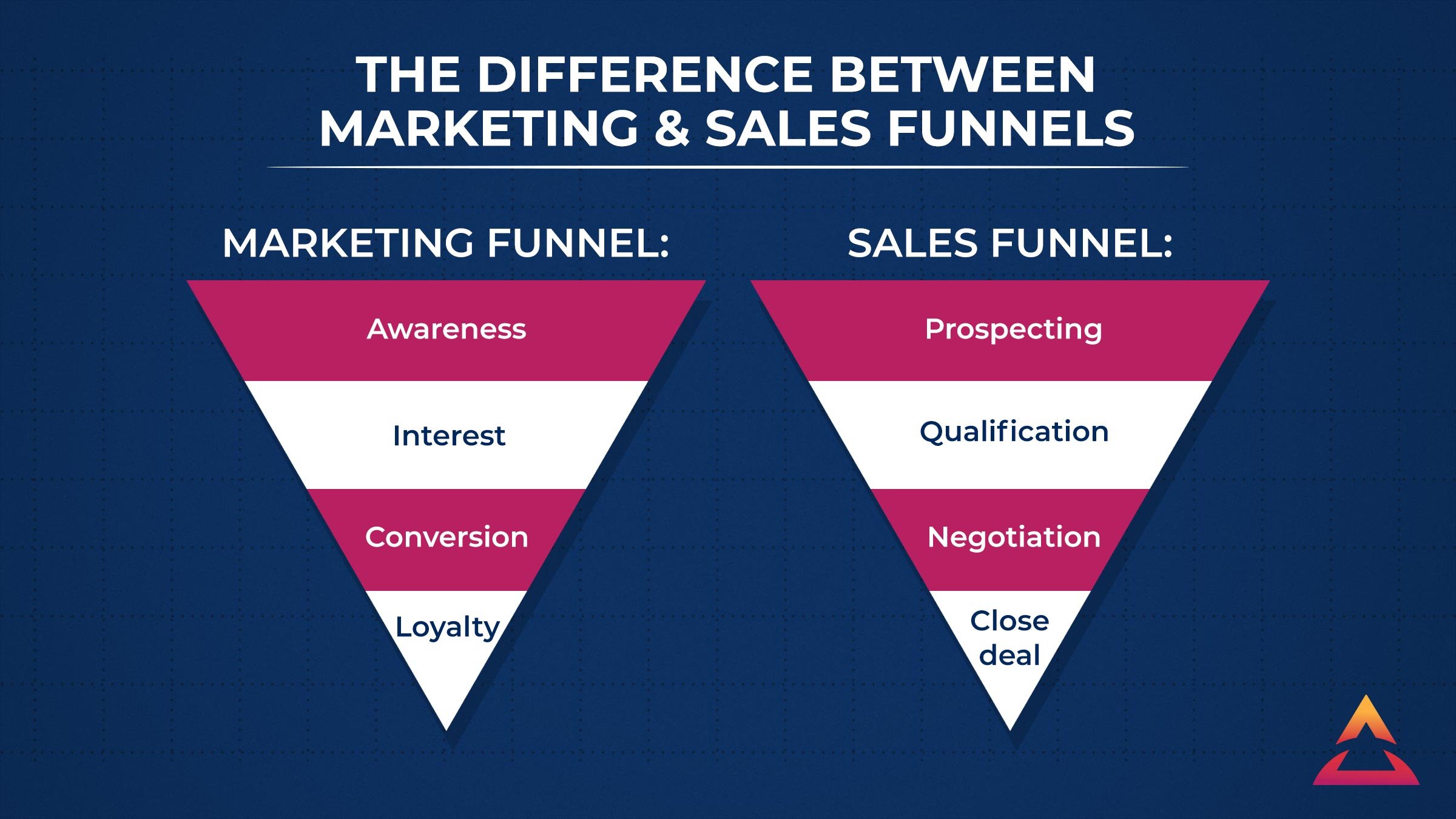There is a whole journey involved with a customer, from the initial lead to a handshake or the signature on the dotted line or the click on the ‘buy’ button. This process of guiding customers down the sales path to your door is called a sales funnel. It’s a great model for tracking the customer journey and understanding where to aim for different products and different price points.
In this blog, we will help you understand what a sales funnel is and why you need one in your sales process in your business. It's all a part of the bigger sales training journey we can take you on. Check out more of our training and resources on how to improve your sales..
What is a sales funnel?
A sales funnel is a model that represents a customer’s journey towards your ideal price point, to which they then become a customer.
Imagine a funnel, like the one you use when putting oil into your car. The top of the funnel is wide and open, so it can catch as much of the oil as possible to direct it down into the engine. In terms of a sales funnel, you’re trying to catch the attention of as many people as possible.
These people are considered leads, potential customers. Using the sales funnel framework, you're trying to better qualify all of the potential customers you've captured to ensure they're a right fit to work with you or purchase from you. The sales funnel will allow you to direct them in a smooth and easy customer journey that makes sense.
The importance of a sales funnel and why you need one
The importance of a sales funnel cannot be understated. Some reasons why a sales funnel is important includes:
- It helps you understand a customer's buying journey with you.
- It visualises the different steps for your team to cater to.
- It can help identify holes in the sales journey and give you a chance to attend to them.
- It is also a well-known model and easily understood by anyone joining your sales team.
What are the 4 stages of a sales funnel?
There are four stages to a sales funnel - from awareness all the way down to the action. By better understanding what's involved at each step and the different ways you can promote the journey at that step, you can easily create a sales funnel for multiple products and services.
Let’s step through each stage.
Lead generation
The best way to collect leads is through a free offer. One month free trial, or reaching out to people on LinkedIn. You collect some details from them to do so, such as an email address or phone number. Often in the case of a free trial, you grab credit card details to make the switch over to paid services much easier.
If you have a great offer to entice them to discover more, or join you, you lead them down the funnel into the next stage.
Qualification
Customers are now interested in you, your products and services, and who you are as a brand. They will do some research and compare you to others.
You want to make sure you're qualifying your customers as well. Are there certain demographics you specifically cater to that they might not fit?
You can send a series of EDMs, educating the leads on how they benefit from your products or services, letting them qualify themselves. You can add in some more information through a soft sell, or a testimonial or two.
During this time, the lead is deciding if what you have to offer is right for them. They check you out, your website, your socials, and so on. Remember, not everyone will travel further down the funnel, and that’s okay. It's all about qualifying your prospects into people who are more ready to purchase from you than others.
If you have a great offer and can provide excellent value, you’ll nudge this person into the 3rd stage of the funnel.
Negotiation
The third step is negotiation. The customer has researched your competition and discovered that you’re pretty good. They like what you’re offering and these people want to join you, but what exactly can you offer them?
Can you offer them savings if they purchase in bulk or for an extended subscription? Extended warranty or more after-sales services? What will it take to get to the next step?
What you offer the customer now will help with the next stage in the funnel. Do you have discounts for membership? Special offers for subscribers? Free shipping over a certain amount?
Doing this will help take them to the bottom of this funnel, and the most valuable part of this journey.
Closing the deal
Close the deal. This is where those customers that are open to what you have to offer, like your deal, will sign on the bottom line, click buy now, and join you as a customer.
But make a note here: the bottom of this funnel doesn't mean the end of this customer’s journey. You want to keep them around so they can go around and around your funnel, being a repeat customer. You want them to tell all their friends about the great experience they’ve had, so you get more people tumbling down your sales funnel.

How can you build a sales funnel?
So now that you understand more about this framework, the importance of sales funnel and how it can help you better speak to the right customers for your product or service, building a sales funnel sounds like a great idea, doesn't it? How do you go about creating one that works for you and your company?
Analyse target audiences' behaviour
The most powerful sales funnels are the ones who know who they’re targeting. This gets you the best Return On Investment, or ROI.
How do your customers behave? Do they like to click through directly from social media to buy? Do they want to read content and research before buying?
Speaking to your customers and actually asking them the right questions about their purchasing behaviours will help you create sales funnels that work.
To uncover how to better understand and communicate with your customer check our our 22 Strategies To Increase Sales Short Course.
Create a lead magnet
An important part of the sales funnel is creating a lead magnet that will be beneficial to your audience. You can give a free strategy session, a free audit, a discount code. It will cost your company very little but is of enormous value to your client.
Of course, you capture some data here. You need an email address or a mobile number to follow up with them.
Capture your audience's attention
This follows closely on the heels of the lead magnet. You don’t want the audience to experience just one thing about your awesome brand. You want them to experience more of what you have to offer.
Give them a chance to do so. At the end of your free strategy session, offer them an opportunity to work with you, purchasing part of your service. Give them solutions from the audit that they can implement themselves. Offer extra incentives for them to utilise your discount code.
Help them show that your value is greater than just that first offering.
Start nurturing your leads
This step is a very fine line to walk, but it can reap significant rewards if done well. You want to have a conversation with your leads. If you managed to grab an email address through the lead magnet, now you start an EDM sales channel, offering advice and suggestions, doing some soft selling, giving your potential customers news on events, sales, product updates, and more.
Feed your customers, encourage them, don’t do any hard selling. Let them come to the conclusion to buy under their own steam. Having a constant stream of possible customers will help generate sales if new leads drop.
The most powerful way to market and sell to someone is to lead them to making the decisions themselves - this involves understanding the psychology behind sales. Show them all the benefits, and let them hit the buy button on their own terms.
Convert the lead into a client
Now that this customer has liked your initial offer, has warmed up to your nurturing, they’re ready to buy. You hand them an irresistible offer or a piece of content that is so compelling they need to know more and want more. And they hit BUY.
Plus, because they have had such a positive experience with you and your sales funnel, they’ll be keen shoppers with you going forward. They will tell their friends and family who will begin the sales funnel journey themselves.
For more insights on the best practices to close a sales deal, check our our blog post here.
Conclusion
The better you know the mechanics of sales and the parts to use during the journey, the easier it becomes for you. You can understand the parts of the sales funnel, plug in the pieces you need for a particular target market, and generate sales and profit.
If you want to understand more about the cogs in the sales machine, The Entourage has a fantastic series of courses you can subscribe to. Look at our sales training and courses, as part of the larger business-training course, so you can build a sales funnel quickly and easily. For more information on sales funnel services, feel free to get in get in touch.
Related Categories
Andrew Macfarlane
Andrew is The Entourage's current Elevate Coaching Manager bringing 15+ years of sales, marketing and management experience. Most recently he held the position of Group Director of Sales for The Star, one of the largest ASX listed integrated resort and entertainment companies, and has been the Director of Sales & Marketing at Stamford Hotels & Resorts too. With multimillion dollar budgets across multiple locations and various assets and having extensive experience leading large sales, marketing and operations teams he understands what it takes to deliver results. Andrew is also the Founder of Running For Wild Dogs, who focus on raising awareness and vital funds for the conservation of African Wild Dogs.





